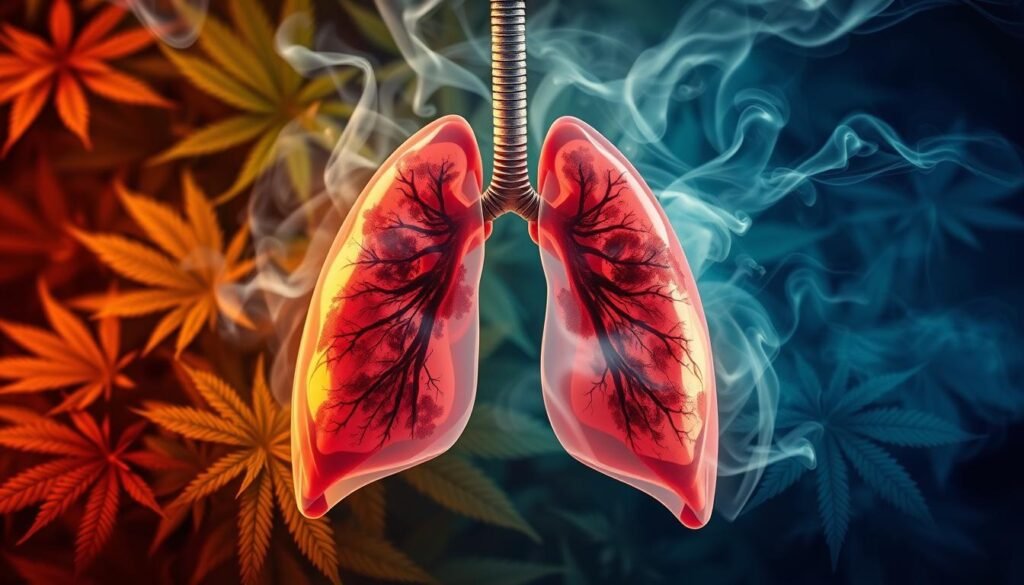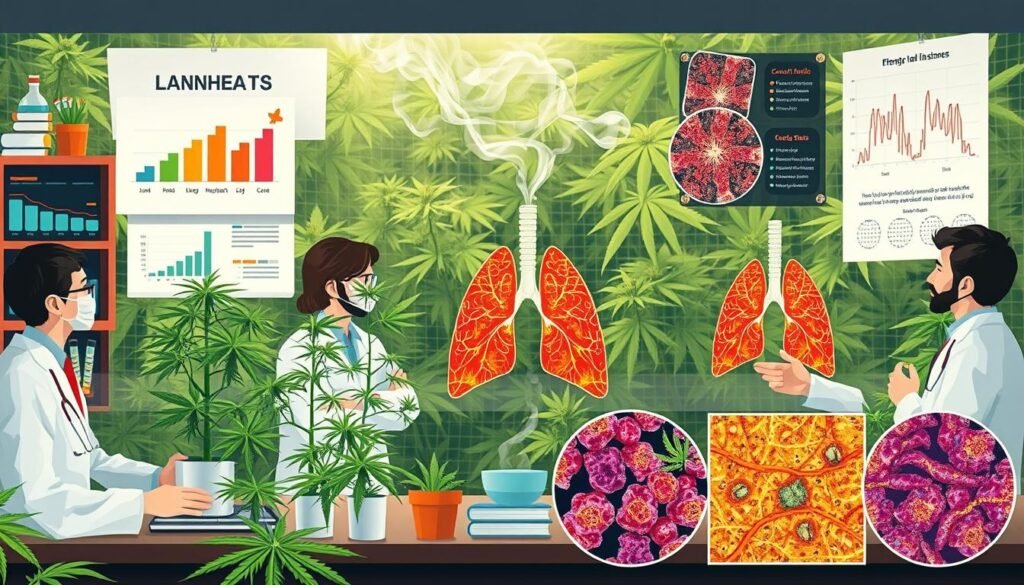Recent studies show a notable 8% rise in lung cancer risk for every joint-year of cannabis smoking. This finding emphasizes the need to understand how marijuana affects lung health. As laws change and acceptance grows, many wonder if smoking marijuana leads to lung cancer. It’s key to note that marijuana smoke has harmful substances found in tobacco smoke. This includes dangerous carcinogens like benzo(a)pyrene and phenols. The American Lung Association and health experts are raising alarms about the risks of smoking cannabis. They urge people to be more informed about how it’s used and its health effects.
This article explores essential health facts about smoking marijuana. We focus on current research and the importance of regular health check-ups. These can help spot any lung problems early, like the symptoms discussed here, including trouble breathing and coughing up blood. With the popularity of cannabis, knowing the risks it carries is crucial.
Key Takeaways
- Marijuana smoke contains similar carcinogens to tobacco, posing serious health risks.
- Risk of lung cancer may increase with the frequency and amount of marijuana smoked.
- Research highlights ongoing debates and inconclusive findings regarding marijuana and lung cancer relationships.
- Regular use can lead to airway injury and inflammation.
- Secondhand marijuana smoke presents risks comparable to tobacco smoke.
- Further research is essential to better understand the long-term effects of cannabis on lung health.
Understanding Marijuana and its Consumption Methods
Marijuana has many ways of being used. Pipes, bongs, blunts, and joints are common methods. Each one gives a different experience and has various health effects.
Edibles, like candies and brownies, are becoming more liked, as well as capsules and drinks with cannabis. These options may seem safer but can be risky if used wrongly. How you choose to use marijuana can impact your lung health.
Studies show smoking is worrisome because of combustion. It releases harmful stuff, like Benzo(a)pyrene and Benz(a)anthracene, which are also in tobacco smoke. These can cause lung problems and chronic bronchitis, which include symptoms like wheezing and more mucus.
Knowing how marijuana affects you is key. Regular smokers often have thicker and inflamed airways and lung damage. This shows why it’s important to understand different ways of using marijuana and their health effects.
More people in the U.S., especially young adults, are using marijuana. This trend makes us wonder about the health effects of different usage methods. It highlights the need for more research on the long-term effects of each consumption way.
| Consumption Method | Potential Health Risks |
|---|---|
| Pipes | Increased risk of lung irritation; exposure to harmful substances. |
| Bongs | May reduce some toxins but still exposes users to dangerous chemicals. |
| Blunts | Combines tobacco and cannabis, increasing cancer and respiratory risks. |
| Joints | Direct exposure to harmful smoke; potential for chronic bronchitis. |
| Edibles | Risk of overconsumption; delayed effects can lead to accidental overdoses. |
Health Effects of Marijuana Smoke on the Lungs
Marijuana smoke affects lung health significantly, leading to multiple respiratory issues. Users often experience a chronic cough, more sputum, and wheezing. These issues show the weed lung health effects from smoking marijuana over time. Studies suggest that marijuana smoke can harm the airways’ cell linings. This harm might lead to chronic bronchitis, known for persistent coughing and much mucus.
The marijuana smoke impact on health goes beyond just immediate symptoms. Researchers found toxins and carcinogens in marijuana smoke similar to those in cigarettes. This finding worries people about the long-term impact on lungs, especially for those with weaker immune systems who face more risks from these toxins.

According to a UK survey, about 2.1 million adults used cannabis in 2016. This rising number shows more countries, like the USA, are okaying its use. Yet, it’s key to know the health risks before lighting up. Long-term use can cause chronic bronchitis and harm lung function.
Vaping cannabis is trending, especially with the younger crowd. Many think it’s safer than smoking. But research shows vaping still pushes harmful chemicals into the body. These chemicals can irritate the airways, making vaping as risky as smoking.
It’s important to understand cannabis use comes with health risks. Quitting resources are not as widespread as those for tobacco, but help exists. The Substance Abuse and Mental Health Services offer support for those wanting to cut down or stop their use. Knowing the lung damage from cannabis is crucial for users and those looking into other options like edibles, which don’t affect the lungs but still need careful dosing.
| Health Impact | Symptoms | Notes |
|---|---|---|
| Chronic Bronchitis | Chronic cough, excess sputum | Related to prolonged use of marijuana smoke |
| Lung Function Impairment | Wheezing, shortness of breath | May not show significant association in short-term studies |
| Airway Inflammation | Coughing, difficulty breathing | Can result from both smoking and vaping |
| Potential Infections | Increased susceptibility | THC may suppress immune response |
Does Smoking Marijuana Cause Lung Cancer
The debate over the pot smoking cancer link is ongoing in the health community. Cannabis smoke harbors harmful substances like marijuana carcinogens, including tar and hydrogen cyanide. While some research links marijuana use to lung cancer, or cannabis-related lung cancer, others do not find strong evidence.
This inconsistency often comes from how marijuana is used differently than tobacco.
Cannabinoids and Carcinogens in Marijuana Smoke
Studies show marijuana smoke contains carcinogens similar to tobacco smoke. Cannabis users tend to inhale more deeply and hold the smoke longer. This increases their lungs’ exposure to these harmful substances.
Compared to tobacco, cannabis smoke puts more tar in the lungs. This fact raises concerns about marijuana’s long-term impact on health.
Comparison of Marijuana and Tobacco Smoke
Understanding the differences between tobacco and marijuana smoke is key. Tobacco smoke is closely linked to lung cancer, responsible for most lung cancer deaths. But marijuana and tobacco smoke both have carcinogens.
Health outcomes vary among marijuana users compared to those who smoke tobacco. The tobacco marijuana smoke comparison highlights these differences. Tobacco use is closely linked to lung cancer, while marijuana’s effects are less clear and more complex.

Marijuana Smoking Risks: What the Research Says
Research on the risks of smoking marijuana shines a light on the long-term impacts. Studies have found that heavy use may increase lung cancer risk. A study in Canada in 2022 showed that smoking marijuana can damage the lungs as much as regular cigarettes do.
Longitudinal Studies and Their Findings
Long-term studies about marijuana use give us varied results. Though it’s hard to directly link it to lung cancer, the similarities to tobacco smoke concern researchers. They think there might be a connection because lung cancer takes years to develop. Research also shows that one joint might have as many harmful substances as 10 to 20 cigarettes.
Research Limitations in Studying Marijuana and Lung Cancer
Studying the cancer risks of marijuana faces big challenges. Often, research relies on what people say about their smoking habits, which might not be accurate. Plus, many who smoke marijuana also use tobacco, making it hard to tell which is causing what effects. These issues make it difficult to find clear answers about marijuana and lung cancer risks.

| Study Factor | Marijuana | Tobacco |
|---|---|---|
| Potential Carcinogens | Similar to 10-20 cigarettes | Known lung cancer risk factor |
| Latency Period | Decades speculated | Decades observed |
| Impact of Combustion | Tar and harmful substances | Tar and harmful substances |
| Self-Reported Use | Often unreliable | More straightforward assessments |
| Health Risks | Potential lung damage identified | Leading cause of lung cancer |
Pulmonary Effects of Cannabis Smoking
Health experts worry about how smoking marijuana affects lung health. Regular use can lead to lung problems like chronic bronchitis. This condition causes a constant cough and more mucus. Smoking marijuana can also harm lung function over time. It’s important to understand these risks.
Chronic Bronchitis and Lung Function
Marijuana use can cause chronic bronchitis. Users often cough and wheeze, and they’re at risk for lung infections. The smoke has harmful chemicals, like those in tobacco, that damage the lungs. The American Lung Association stresses the importance of studying cannabis’s impact on breathing. For more details, visit here.
Airway Inflammation and Damage
Smoking weed can inflame the airways. Regular users may have lung problems and symptoms like shortness of breath and a rough voice. The damage can be long-term. And just like tobacco, secondhand weed smoke is dangerous, especially for children. There’s ongoing research into how weed affects breathing.
| Condition | Symptoms | Potential Risks |
|---|---|---|
| Chronic Bronchitis | Cough, wheezing, mucus production | Long-term lung damage, infections |
| Airway Inflammation | Shortness of breath, hoarse voice | Chronic lung conditions, compromised respiratory health |
| Lung Function Issues | Decreased forced expiratory volume | Increased risk of respiratory disease |
Secondhand Marijuana Smoke: Risks and Concerns
Secondhand marijuana smoke poses significant health risks. It is especially risky for vulnerable groups. It contains many of the same toxic and cancer-causing chemicals found in tobacco smoke. Some levels are even higher. This can lead to negative health effects, particularly in children and those with pre-existing medical conditions.
Impact on Vulnerable Populations
Children are especially at risk from marijuana smoke. Studies show a link between household cannabis use and THC levels in children. Brief exposure to secondhand cannabis smoke might cause psychoactive effects. This risks issues with attention, memory, or motivation during adolescence. Many children living in homes where cannabis is used have shown biological signs of THC.
Public Health Implications
The rise in marijuana consumption in the United States is a public health concern. The rate of marijuana use among adults rose from 4.1% to 9.5% between 2001-2002 and 2012-2013. This increase underlines the need for effective cannabis regulation. Joint emissions are much greater than those from cigarettes, highlighting the need for rules against secondhand exposure in public areas.
| Health Impact | Exposure Source | Statistics |
|---|---|---|
| Cancer Risk | Secondhand Marijuana Smoke | Contains toxic chemicals similar to tobacco |
| Cardiovascular Issues | Inhalation of Particulates | 4.4 times higher PM2.5 from marijuana than tobacco |
| Psychoactive Effects | THC Exposure in Children | Nearly half of children show biological exposure |
| Indoor Air Pollution | Use of Vaporizers | PM2.5 levels comparable to extreme pollution events |
Secondhand marijuana smoke raises complex health challenges. Public health campaigns are vital to raise awareness of these risks. These efforts are crucial in communities heavily affected by cannabis use. Stronger regulations are needed to protect both users and those around them.
The Link Between Cannabis Use and Immune Function
Regular use of marijuana is in the spotlight for how it might affect health, especially the immune system. The active chemicals, called cannabinoids, interact with the body’s endocannabinoid receptors. This can weaken the immunity, making it easier to get sick.
Weakened Immune Defenses
Using marijuana can cause the body to make more cells that lower immunity. This means the body can’t fight diseases as well. It can also lead to higher levels of certain proteins and inflammation, making it harder to stay healthy. The lungs, in particular, can have a hard time defending against illnesses.
Increased Risk of Infections
Using cannabis can make you more likely to get infections. People who smoke marijuana may get lung infections more often than those who don’t. It’s important to know about the link between smoking cannabis and lung problems. Users might end up needing medical help for these issues more often.
| Type of Risk | Effect on Immune Function | Common Infections |
|---|---|---|
| Weakened Immunity Due to Cannabis | Increased immune suppressor cells | Pneumonia, bronchitis |
| Respiratory Infection Risks | Increased inflammatory cytokines | Viral infections |
| Lung Infections | Impaired lung defenses | Chronic bronchitis |
Knowing about these issues is key in understanding the health risks from using marijuana. For more on how cannabis affects immune function, click here for additional information.
Vaping Marijuana: A New Concern
Vaping marijuana is getting more popular but comes with big health risks. Studies show that vaping cannabis might cause lung injuries like those from smoking. Research found that CBD aerosols could cause more lung damage than nicotine. The Roswell Park Comprehensive Cancer Center discovered that breathing in CBD aerosols leads to severe lung problems and more oxidative stress. This shows the dangers of marijuana vaping that users need to know about.
Breathing in CBD aerosols was also linked to a higher death rate of certain immune cells and lower levels of key lung cells than nicotine. This makes it vital for public health experts to study how vaping cannabis affects lung health over time. The rise in EVALI cases, linked to THC in cannabis oils or vapes, makes this research even more urgent.
Even though cannabis might have some health benefits, smoking or vaping it can be harmful. Vaping devices can have flavorings and chemicals that might cause serious lung issues. Conditions like popcorn lung and lipoid pneumonia have been connected to these substances. It’s important for users and healthcare providers to understand the risks of vaping marijuana as they deal with changing cannabis use.